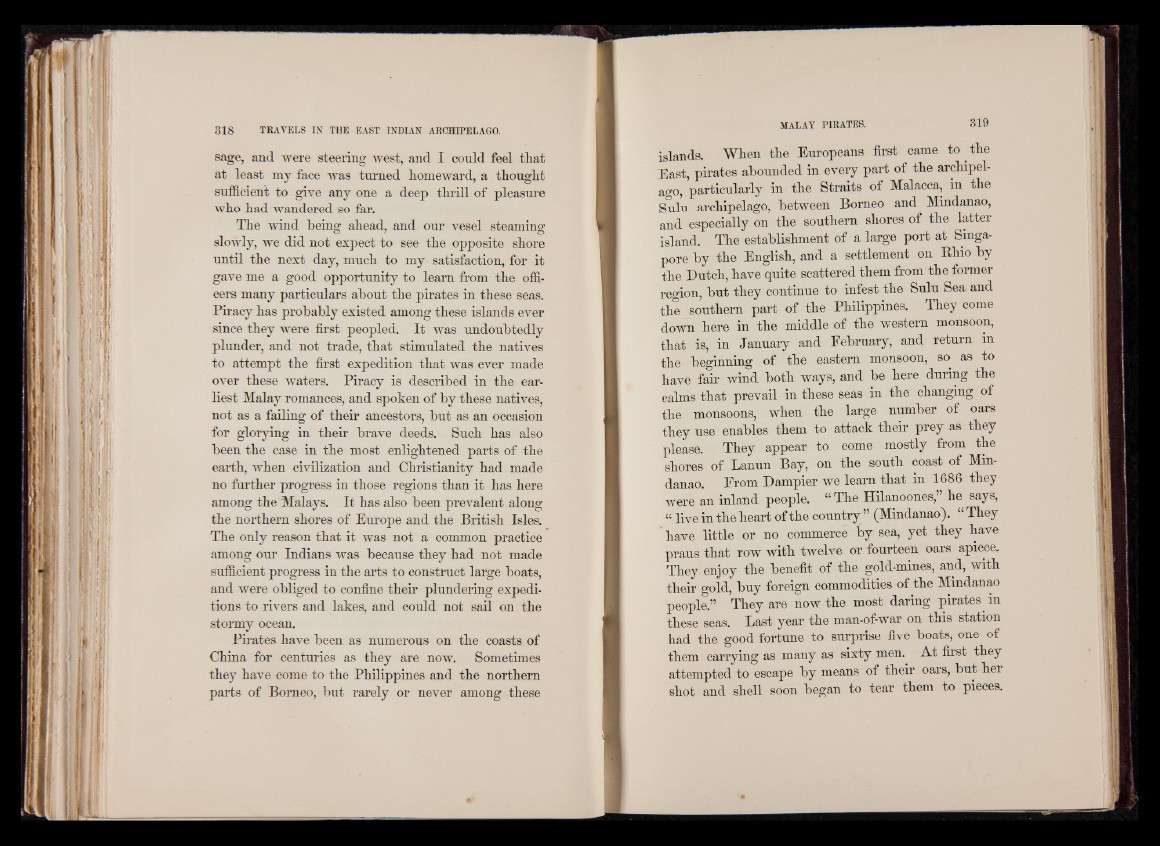
sage, and were steering west, and I could feel tliat
at least my face was turned homeward, a thought
sufficient to give any one a deep thrill of pleasure
who had wandered so far.
The wind being ahead, and our vesel steaming
slowly, we did not expect to see the opposite shore
until the next day, much to my satisfaction, for it
gave me a good opportunity to learn from the officers
many particulars about the pirates in these seas.
Piracy has probably existed among these islands ever
since they were first peopled. It was undoubtedly
plunder, and not trade, that stimulated the natives
to attempt the first expedition that was ever made
over these waters. Piracy is described in the earliest
Malay romances, and spoken of by these natives,
not as a failing of their ancestors, but as an occasion
for glorying in their brave deeds. Such has also
been the case in the most enlightened parts of the
earth, when civilization and Christianity had made
no further progress in those regions than it has here
among the Malays. It has also been prevalent along
the northern shores of Europe and the British Isles.
The only reason that it was not a common practice
among our Indians was because they had not made
sufficient progress in the arts to construct large boats,
and were obliged to confine their plundering expeditions
to rivers and lakes, and could not sail on the
stormy ocean.
Pirates have been as numerous on the coasts of
China for centuries as they are now. Sometimes
they have come to the Philippines and the northern
parts of Borneo, but rarely or never among these
islands. When the Europeans first came to the
East, pirates abounded in every part of the archipelago,
particularly in the Straits of Malacca, in the
Sulu archipelago, between Borneo and Mindanao,
and especially on the southern shores of the latter
island. The establishment of a large port at Singapore
by the English, and a settlement on Rhio by
the Dutch, have quite scattered them from the former
region, but they continue to infest the Sulu Sea and
the southern part of the Philippines. They come
down here in the middle of the western monsoon,
that is, in January and February, and return in
the beginning of the eastern monsoon, so as to
have fair wind both ways, and be here during the
calms that prevail in these seas in the changing of
the monsoons, when the large number of oars
they use enables them to attack their prey as they
please. They appear to come mostly from the
shores of Lanun Bay, on the south coast of Mindanao.
From Dampier we learn that in 1686 they
were an inland people. “ The Hilanoones,” he says,
1 live in the heart of the country ” (Mindanao). g They
have little or no commerce by sea, yet they have
praus that row with twelve or fourteen oars apiece.
They enjoy the benefit of the gold-mines, and, with
their gold, buy foreign commodities of the Mindanao
people.” They are now the most daring pirates^ in
these seas. Last year the man-of-war on this station
had the good fortune to surprise five boats, one of
them carrying as many as sixty men. At first they
attempted to escape by means of their oars, but her
shot and shell soon began to tear them to pieces.